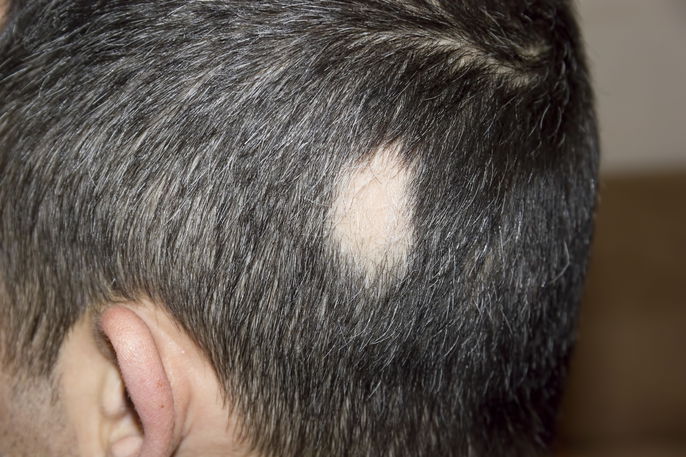Alopecia areata is a type of alopecia that affects the hair follicles, leading to hair loss and/or hair loss on parts of the body. It can affect the eyebrows, beard, legs or arms, with hair loss often being sudden and in circular patches.
The exact cause of alopecia areata is not yet fully known, but it is believed to be autoimmune response, in which the immune system produces antibodies that attack healthy cells in the hair follicles. It can also develop due to genetic factors.
If you suspect you have alopecia areata, you are advised to consult a dermatologist. Treatment depends on the severity of the condition, and may include the use of ointments applied to the scalp or injections to manage hair loss.

Main symptoms
The main symptoms of alopecia areata are:
- Sudden hair loss on the scalp, beard, eyelashes, eyebrows, or any part of the body that has hair;
- Circular or rounded patches of hair loss, leaving an area of smooth, shiny skin;
- Hair strands that look like exlamation points on the edges of the hairless patches;
- Broken or short hairs in the affected area;
- Itching or burning in the area before the hair or hair falls out, in some cases.
Although there is no hair in the affected area, the hair follicles are not destroyed and, when the hair grows back in the area, it may be white or gray before returning to its normal color.
In some cases, the person may be completely hairless on the head or entire body. Some patients may also have changes to their nails, like small dents, cracks, red spots or total nail loss.
Confirming a diagnosis
An alopecia areata diagnosis is made by a dermatologist by assessing the patient's symptoms and the characteristics of the hair loss.
The doctor usually performs a dermatoscopy exam to evaluate the affected area in more detail and, in some cases, may also order antibody blood testing or a skin biopsy to rule out other health problems.
Possible causes
The cause of alopecia areata is not fully known. It is thought that it is a multi-factorial condition that can be related to several conditions, like:
- Genetics
- Autoimmune diseases, like vitiligo and lupus
- Stress
- Anxiety
- Thyroid abnormalities
It is important for the causes related to the alopecia to be identified, as treatment of these causes may help to improve symptoms and stimulate hair regrowth.
Treatment options
Treatment should be guided by a dermatologist depending on the type of alopecia and the underlying cause. The dermatologist may recommend:
- Cortisone injections: These are injected once per month in the areas where hair has fallen. The dermatologist may also advise the use of creams or lotions to apply following injections.
- Topical minoxidil: This is a liquid lotion applied twice per day in the areas of hair loss. It is not effective for total hair loss.
- Anthralin: This is sold as a cream or ointment, and should be applied in the affected regions. Note that it may cause changes to skin color. Dosing of this medication should be at the discretion of the doctor.
Severe cases of alopecia that results in hair loss in multiple areas of the body can be treated with corticosteroids and immunosuppressants as prescribed by the doctor.
Other tips
Other care measures for alopecia areata includes using makeup to lessen the appearance of hair loss and wearing hats or scarves to protect the head during treatment.
It is also important to take steps to relieve stress, such as taking time to rest and exercising regularly, as hair loss can worsen during these periods in some cases.
Does alopecia areata heal on its own?
Alopecia areata can heal on its own in some cases, but it is common for hair to fall out again in the same affected area. Although rare, hair loss can also worsen and affect hair all over the body in some people.
In any case, it is important to consult a dermatologist for an evaluation and diagnosis of alopecia areata, and if necessary, to undergo treatment, since hair loss can cause psychological disorders and affect quality of life.
Also recommended: tuasaude.com/enHow long does alopecia areata last?
The duration of alopecia areata is unpredictable amount. Children who have few bald patches can experience alopecia areata for up to 6 to 12 months after onset.






























